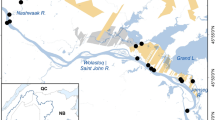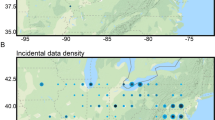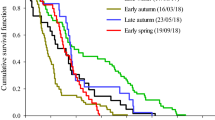Abstract
TWO types of British dragonfly have been recognized, namely, spring and summer species. Spring species (for example, Anax imperator Leach, Pyrrhosoma nymphula (Sulzer)) have been defined as those having a diapause in the final larval instar and, in consequence, a closely synchronized emergence. In summer species (for example, Aeshna cyanea (Müller), Lestes sponsa (Hansemann)) diapause is by definition absent from the final instar, although sometimes developed in another stage in the life-history1. The lack of a final instar diapause in summer species made it seem likely that emergence in this ecological group would be less closely synchronized than in spring species, and that in some cases it might inherit from the larval population a time – frequency distribution approaching normality2. Although emergence of L. sponsa has been found to be temporally dispersed3, when compared with that of P. nymphula 2, its exact temporal distribution and duration have hitherto remained unknown. Recently, however, the emergence pattern of another summer species, A. cyanea, has been determined directly by means of exuvia counts made in Nature, and the results provide a striking confirmation of expectation.
This is a preview of subscription content, access via your institution
Access options
Subscribe to this journal
Receive 51 print issues and online access
$199.00 per year
only $3.90 per issue
Buy this article
- Purchase on SpringerLink
- Instant access to full article PDF
Prices may be subject to local taxes which are calculated during checkout
Similar content being viewed by others
References
Corbet, P. S., Nature, 174, 655 (1954).
Corbet, P. S., J. Anim. Ecol., 21, 206 (1952).
Corbet, P. S., Tijdschr. Ent., 99, 217 (1956).
Moore, N. W., J. Anim. Ecol., 22, 344 (1953).
Author information
Authors and Affiliations
Rights and permissions
About this article
Cite this article
CORBET, P., CORBET, S. Emergence of a Summer Species of Dragonfly. Nature 182, 194 (1958). https://doi.org/10.1038/182194a0
Issue date:
DOI: https://doi.org/10.1038/182194a0



